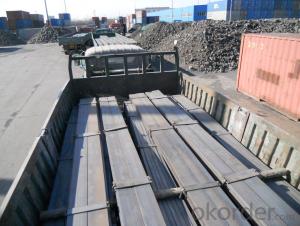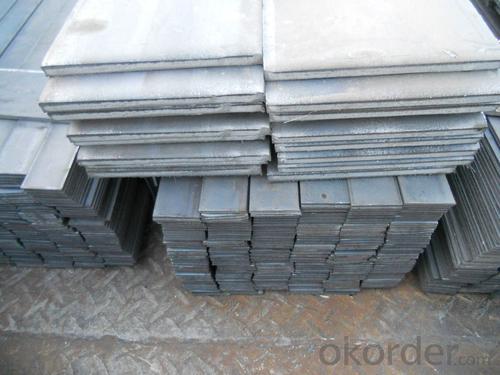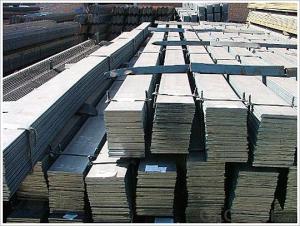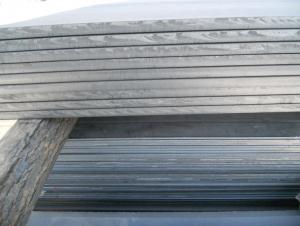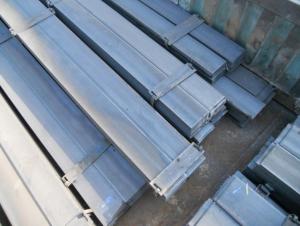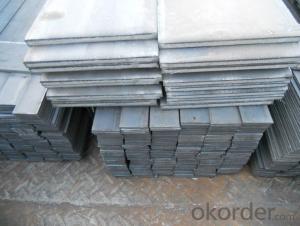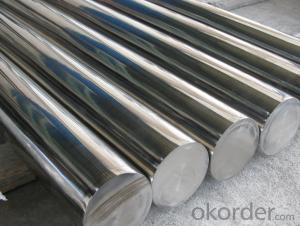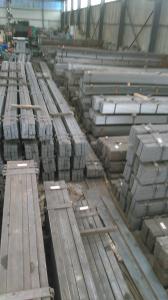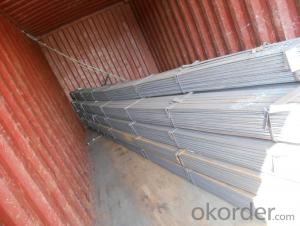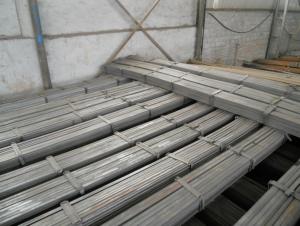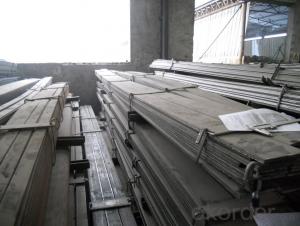manufacture direct supply steel flat; flat steel bars
- Loading Port:
- Tianjin
- Payment Terms:
- TT or LC
- Min Order Qty:
- 1000 m.t.
- Supply Capability:
- 10000 m.t./month
OKorder Service Pledge
OKorder Financial Service
You Might Also Like
Commodity: Q235 Steel Flat Bar
Standard: GB
Material: Q235
Brand name: FLATSPACE
Origin place: China
Thickness: 3mm-30mm
Width:20mm-200mm
Length: Max 12m
Certification: SGS/BV
Chemical composition of Q235
Alloy No | Grade | Element(%) | ||||
C
| Mn
| S
| P
| Si
| ||
Q235
|
B
|
0.12—0.20 |
0.3—0.7 |
≤0.045 |
≤0.045
|
≤0.3
|
Physical properties of Q235
Alloy No | Grade | Yielding strength point(Mpa) | Tensile strength (Mpa) | Elongation after fracture(%) | ||||||
Thickness (mm) | Thickness (mm) | |||||||||
≤16 | >16--40 | >40--60 | >60--100 | ≤16 | >16--40 | >40--60 | >60--100 | |||
≥ | ≥ | |||||||||
Q235 |
B |
235 |
225 |
215 |
205 |
375--500 |
26 |
25 |
24 |
23 |
Usage/Applications of Q235 Steel Flat Bar
Widely used for construction, Machinery manufacturing, Iron tower steel structure, Shipbuilding; Steel grating, Staircase, Bridge, Viaduct, Railway spare parts, Boilers making etc.
Production Flow of Q235 Steel Flat Bar
The steel flat bar is made through three processes:
1.Feeding the material: Feeding the row material (the steel plate) to Slitting Line.
2.Slitting:The steel plate would be slitted into expected width by lengthways cutter.
3. Leveled and cutting: The plat bar would be ground into level by the grinder and then cut into required length.
Packaging & Delivery of Q235 Steel Flat Bar
Packaging Details: The Steel Flat Bars are packed in bundles and loaded in 20 feet/40 feet container, or shipped by bulk cargo ,also we can do as customer's requirements.
Delivery Details:30~45 days upon the receipt of buyer payment by T.T. or L/C.
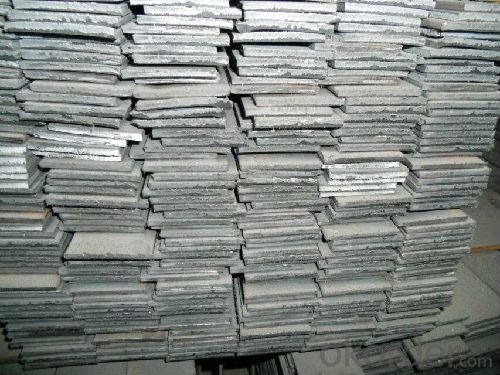
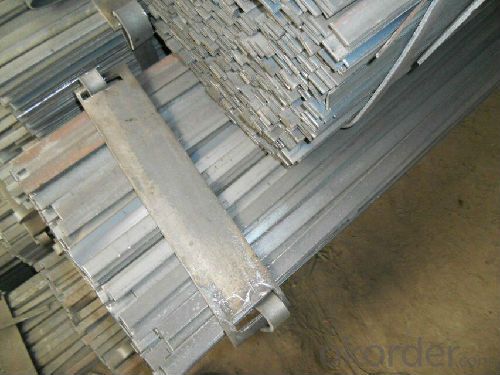
- Q: What are the common standards or specifications for steel flat bars?
- There are several common standards and specifications for steel flat bars, which help ensure consistency and quality in their production and usage. Some of the most widely recognized standards include: 1. ASTM A36/A36M: This standard specifies the requirements for carbon structural steel, including steel flat bars. It covers various dimensions, chemical composition, mechanical properties, and tolerances. 2. ASTM A108: This specification outlines the requirements for carbon steel bars, including flat bars, used in general structural purposes. It covers different grades and classes of carbon steel, as well as their chemical composition, mechanical properties, and tolerances. 3. ASTM A666: This standard specifically addresses the requirements for austenitic stainless steel flat bars. It provides specifications for chemical composition, mechanical properties, dimensions, and surface finishes. 4. EN 10058: This European standard specifies the dimensions, tolerances, and technical delivery conditions for hot-rolled flat steel bars. It covers various steel grades and provides guidelines for the manufacturing process and surface quality. 5. JIS G3101: This Japanese standard defines the general requirements for hot-rolled steel plates, sheets, and strips, including flat bars. It includes specifications for chemical composition, mechanical properties, dimensions, and tolerances. It is important to note that specific industries or applications may have additional requirements or standards for steel flat bars. For example, the construction industry often refers to specific local building codes or standards, while the automotive industry may have its own proprietary specifications. Therefore, it is essential to consider the intended use and consult the relevant standards and specifications to ensure compliance and suitability for a particular project or application.
- Q: How do steel flat bars contribute to the overall safety of structures?
- Steel flat bars contribute to the overall safety of structures by providing strength, durability, and stability. They are commonly used in construction to reinforce beams, columns, and other structural components, enhancing their load-bearing capacity and resistance to bending or warping. Steel flat bars also distribute the weight of a structure evenly, reducing the risk of structural failure or collapse. Additionally, their rigidity and resistance to corrosion make them reliable and long-lasting, ensuring the safety and stability of the overall structure for an extended period of time.
- Q: What is the maximum length-to-thickness ratio for steel flat bars?
- The maximum length-to-thickness ratio for steel flat bars depends on various factors such as the type of steel, the intended application, and the specific requirements of the project. However, as a general guideline, the maximum length-to-thickness ratio for steel flat bars is typically around 200:1 or less. This means that the length of the flat bar should not exceed 200 times its thickness. It is important to note that exceeding the recommended length-to-thickness ratio can lead to potential issues such as reduced structural integrity, increased bending or buckling tendencies, and decreased load-bearing capacity. Therefore, it is crucial to consult with structural engineers or professionals with expertise in steel design to determine the appropriate length-to-thickness ratio based on the specific application and requirements.
- Q: What are the different types of surface treatments available for steel flat bars?
- There are several surface treatments available for steel flat bars, including hot-dip galvanizing, electroplating, powder coating, painting, and passivation.
- Q: How do you cut a steel flat bar?
- To cut a steel flat bar, you can use various tools such as a hacksaw, angle grinder with a cutting disc, or a metal-cutting band saw. It is recommended to securely clamp the bar before cutting and wear appropriate safety gear for protection.
- Q: Can steel flat bars be used as handrails?
- Indeed, handrails can be fashioned from steel flat bars. These bars are frequently employed for this purpose owing to their robustness and longevity. They offer a firm and secure hold for individuals and are capable of enduring substantial weights. Furthermore, steel flat bars can be readily tailored and molded to suit any preferred pattern or fashion. They may also be painted or coated with a safeguarding finish to augment their aesthetic appeal and avert corrosion. Ultimately, steel flat bars are widely favored for handrails in residential as well as commercial settings.
- Q: Do steel flat bars have a specific grain orientation?
- Steel flat bars do not have a specific grain orientation, unlike materials like wood or certain metals. Steel does not display a visible grain structure. It is an alloy primarily composed of iron and carbon, as well as other elements. The microstructure of steel consists of small crystals called grains. However, these grains are randomly positioned in steel, resulting in no specific direction or pattern of grain orientation in flat bars. This random grain structure contributes to the isotropic properties of steel, ensuring equal strength and durability in all directions.
- Q: What is the difference between a steel flat bar and a steel channel?
- The shape and design of a steel flat bar and a steel channel differ significantly. A steel flat bar is a rectangular piece with straight edges, commonly utilized in the construction and manufacturing industries for various purposes such as supports, braces, and frames. Its flat surface provides stability and strength, making it ideal for load-bearing tasks. The width and thickness of the bar can be adjusted according to project specifications. On the contrary, a steel channel is a C-shaped structural element comprising two flanges and a web in the middle. The flanges are positioned perpendicular to the web, giving the channel its distinctive form. Channels are extensively employed in construction, particularly for framing buildings and creating structural support systems. The flanges offer strength and rigidity to the channel, making it suitable for applications that require lateral support and stability. To summarize, the primary distinction between a steel flat bar and a steel channel lies in their shape and structural design. While the flat bar is a long rectangular piece with straight edges, the channel possesses a C-shaped profile with flanges and a web. The selection between the two depends on specific project requirements and the type of load-bearing or support function it needs to fulfill.
- Q: What are the different surface treatments available for steel flat bars?
- There are several different surface treatments available for steel flat bars, each providing unique advantages and characteristics. Some of the common surface treatments for steel flat bars include: 1. Hot-dip galvanizing: This process involves immersing the steel flat bar in a bath of molten zinc, which creates a protective coating on the surface. Hot-dip galvanizing provides excellent corrosion resistance, making it suitable for outdoor applications where the steel may be exposed to moisture or harsh environmental conditions. 2. Electroplating: Electroplating involves depositing a thin layer of metal onto the surface of the steel flat bar through an electrochemical process. This treatment can be used to enhance the appearance of the steel, improve corrosion resistance, or provide other desired properties, depending on the metal used for plating. 3. Powder coating: Powder coating is a dry finishing process where a fine powder is applied to the steel flat bar electrostatically and then cured under heat. This treatment creates a durable and attractive surface that is resistant to chipping, scratching, and fading. Powder coating is available in a wide range of colors and textures, allowing for customization and versatility. 4. Paint coating: Steel flat bars can be coated with various types of paints to improve aesthetics, provide corrosion protection, or enhance other properties. Different types of paint coatings, such as epoxy, enamel, or polyurethane, can be used depending on the specific requirements and desired appearance. 5. Shot blasting: Shot blasting involves propelling abrasive particles at high speed onto the surface of the steel flat bar to remove rust, scale, and other contaminants. This treatment helps to improve the adhesion of subsequent coatings, such as paints or galvanizing, and provides a clean, smooth surface. 6. Passivation: Passivation is a chemical treatment that removes surface contaminants and forms a protective oxide layer on the steel flat bar. This treatment enhances the corrosion resistance of stainless steel flat bars, making them more suitable for applications where they may be exposed to corrosive environments. 7. Acid etching: Acid etching is a process that involves treating the surface of the steel flat bar with an acidic solution to create a textured or patterned finish. This treatment can be used for decorative purposes or to improve the grip of the steel in certain applications. It is important to consider the specific requirements of your application, such as corrosion resistance, appearance, durability, and cost, when selecting the most appropriate surface treatment for steel flat bars.
- Q: What are the different types of edge finishes available for steel flat bars?
- There are several different types of edge finishes available for steel flat bars, depending on the desired aesthetic and functional requirements. Here are some of the most common types: 1. Square Edge: This is the most basic and simple edge finish, where the edges are left untouched and remain square in shape. It is commonly used for structural applications or when the appearance is not a significant factor. 2. Rounded Edge: Also known as a radius edge, this finish involves rounding off the sharp edges of the flat bar. It provides a smoother and more visually appealing appearance while also improving safety by reducing the risk of injury from sharp edges. 3. Beveled Edge: In this finish, the edges of the flat bar are cut at a specific angle, usually at 45 degrees. Beveled edges are often used in applications where two flat bars are joined together at a specific angle, creating a clean and precise joint. 4. Rolled Edge: This type of finish involves rolling the edges of the flat bar to create a curved or rolled appearance. Rolled edges are commonly used for decorative purposes, as they add a unique and stylish touch to the flat bar. 5. Serrated Edge: A serrated edge finish features small notches or teeth along the edges of the flat bar. This type of finish is often used in applications where enhanced grip or traction is required, such as grating or flooring. 6. Chamfered Edge: Chamfering involves cutting a beveled edge along the length of the flat bar, rather than just at the ends. This finish is commonly used to remove sharp corners and make it easier to handle the flat bar. These are just a few examples of the different edge finishes available for steel flat bars. The choice of edge finish will depend on factors such as the intended use, aesthetic preferences, safety requirements, and cost considerations.
Send your message to us
manufacture direct supply steel flat; flat steel bars
- Loading Port:
- Tianjin
- Payment Terms:
- TT or LC
- Min Order Qty:
- 1000 m.t.
- Supply Capability:
- 10000 m.t./month
OKorder Service Pledge
OKorder Financial Service
Similar products
Hot products
Hot Searches
Related keywords

